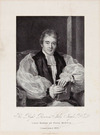relating to Newfoundland occurred in 1810, when he applied for letters patent entitling him to “the exclusive privilege of taking whales” in the island’s coastal waters, by an elaborate, if somewhat fanciful
March 1848 in Charlottetown.
Frederick John Martin Collard emerged suddenly in Prince Edward Island public life in September 1844 when he
, Fleming went to the island in the autumn of 1823. It seems that he first had only temporary leave, to collect funds for the Carrick chapel. Through Scallan’s entreaties alone did the Franciscan authorities
(Stellarton), Fraser travelled extensively throughout the county, his fluency in Gaelic being an important asset. He undertook missionary tours to Cape Breton, Prince Edward Island, and New Brunswick but, apart
.
In 1833 Angus Bernard MacEachern*, the first bishop of the diocese of Charlottetown, which at that time covered Prince Edward Island
Stewart*, a landowner on Prince Edward Island, who hired Goff to be his agent there. The following spring the Goff family moved to the Island, where Fade by 1814 agreed to act also as agent for George
Antigonish, ed. R. A. MacLean (2v., [Antigonish], 1976), 2: 64. Casket (Antigonish), 8 Dec. 1887: 2. C. S. MacDonald, “Early Highland emigration to Nova Scotia and Prince Edward
holder; b. c. 1759 in England; m. 1792 Mary Derby, daughter of the loyalist Benjamin Derby (Darby), in St Eleanors, St John’s (Prince Edward) Island, and they had five
.
During the American Revolutionary War Hill had also become involved with St John’s (Prince Edward) Island, initially in partnership with Edward Lewis, mp, one of the
, and militia officer; b. probably during the winter of 1764–65 at Observation (Holland) Cove, St John’s (Prince Edward) Island, natural first child of Samuel Johannes
the supervision of a diocese which included Nova Scotia, New Brunswick, Prince Edward Island, Newfoundland, and Bermuda. Within five years, during which he made regular episcopal tours, he realized that
.
It is not known when Thomas Irwin emigrated from his native Ireland to Prince Edward Island, or how he earned his living there before receiving licences to teach (1830) and to practise surveying (1835
affairs, particularly after 1832. He was involved in the achievement of independence by Belgium and Greece and in the accession of Prince Leopold to the throne of Belgium, and then was entrusted in July
Canada (1816), Prince Edward Island (1817), New Brunswick (1819), and the Red River colony (1820).
Some time during the early 1820s ill health forced
.
Born into an Anglican, Anglo-Irish family, Francis Longworth immigrated to St John’s (Prince Edward) Island around 1791. He was a tanner by trade, but by no means a simple tradesman: he had
, jp, and office holder; b. c. 1791 on Saint John’s (Prince Edward) Island, son of John MacDonald of West River and Margaret MacDonald of Glenaladale; m. at St Andrews
but supremacy will satisfy such people.” At the time Manahan was himself in the government’s employ. From 1837 to 1844 he was crown lands agent for the Midland and Prince Edward districts and in 1838–40
Colonial Herald, 13 Aug. 1830. Prince Edward Island Register, 29 June 1830. Times and Courier (Halifax), 27 Feb. 1849. Murdoch, Hist. of N
MacEachern* of Prince Edward Island, who had responsibility for Cape Breton at this time, met MacDonell on his first pastoral visit there in 1823; he stated that the priest would need assistance in order
and was appointed to Prince Edward Island.
McCulloch’s education and early years instilled a committed Calvinism, a philosophical liberalism, and an









